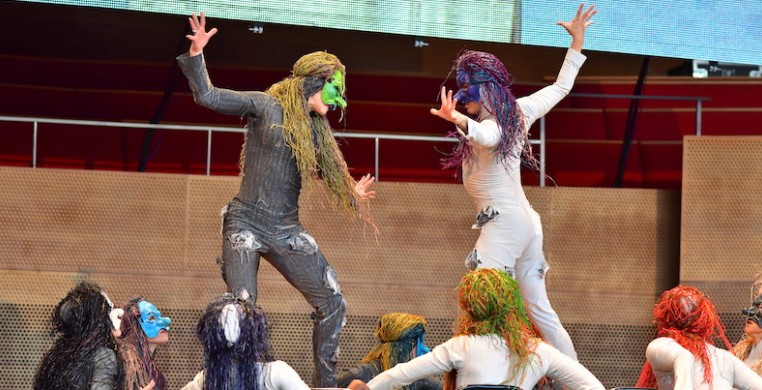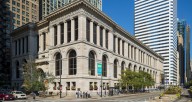UPDATE: The new seechicagodance.com will launch March 31st. Click here to learn more.
SummerDance audiences boogie to new and familiar tunes
SummerDance brings to mind carefree frolicking in the sun and all of the Terpsichorean pleasures of liberation from the shackles of Chicago’s brutal winter. Thanks to a sunny Saturday of perfect summer weather, this year’s one-day outdoor event was just that, offering free performances, dance lessons, and demonstrations spanning all forms of dance for dance lovers of all ages and persuasions.
Now in its third year, the Chicago Department of Cultural Affairs and Special Events, under the direction of commissioner of special events Mark Kelly, has produced “SummerDance Celebration,” the end-of-summer high point, preceded by SummerDance in the Parks, a summer-long dance bonanza of professional performances, ballroom dance lessons, and grassroots groups throughout the city’s neighborhood parks.
In addition to providing a refreshing excuse to get outdoors and boogie to some new tunes with fellow Chicagoans from across the city’s diverse neighborhoods, SummerDance aims to expand the audience for different kinds of dance and gives valuable exposure to smaller, less-well-known companies. Dance Village, held in Wrigley Square from 1-6 p.m., and sponsored by See Chicago Dance, presented no fewer than 23 different Chicago dance companies ranging from Ballet to Belly Dance and everything in between.
The SummerDance Celebration culminated in a free, one-hour performance by seven Chicago dance companies in the Jay Pritzker Pavillion, followed by a social dance party on the Great Lawn.
The variety bill offered something for every taste, from modern dance to contemporary and jazz, flamenco and mambo to hip-hop, with a seventh inning stretch for audience participation with line dancing led from the stage by the pink-clad ladies of Fre2Dance.
Cerqua Rivera Dance Theatre, Joel Hall Dancers, and Hubbard Street Dance Chicago anchored the program, bringing past favorites to an audience that might not have otherwise had an opportunity to experience the high-caliber dancing and sophisticated modern concert dance choreography represented by these three companies. More commercially familiar dance forms of hip hop, break dance, and footwork alternated with spin-offs from flamenco and the mambo to complete a mixed bill with diverse cultural references.
Preceding the formal concert performance at 6:30 p.m., the ragtag physical antics of Mucca Pazza, a crazy, Commedia-like marching band, wound its colorful way onto the Pritzker stage for a prelude, complete with tuba farts and low-brow, pom-pom-weilding cheer-leaders. A zealous drum corps accompanied the ensemble of saxophones, trombone, trumpet, cello, violin and glockenspiel.
Mucca Pazza’s exit into the wings made an unlikely segue to Monique Hayley’s intensely serious modern dance choreography for Cerqua Rivera’s performance, excerpted from her 2018 work, “ROOT.” Inspired by her life and heritage, she collaborated with composer Joe Cerqua to investigate the relationship of the body and spirit in dance. A live, on-stage drummer accompanied the eight dancers, while Cerqua’s recorded instrumental jazz score blended seamlessly from Pritzker’s brand new sound system. Hayley’s movement paralleled the percussive accents of the music with sudden, thrusting arm gestures, hand flicks and trembling, a range that sought its extreme limits in split-leg extensions and fierce assertiveness. Cerqua Rivera’s polished women sport a leggy virtuosity in this fast-paced mirror of Cerqua’s jazzy score, while the men’s skilled partnering caught them on the fly. Hayley gave the men their due in a series of solo spots for each to demonstrate his unique style and voracious appetite for space.
The four women in Kimberly Rivera’s flamenco and New York mambo-inspired “La Fanta,” and Columbia College Chicago’s hip-hop Rated ‘E’ Dance Crew brought variety and cultural opposites to the mix.
Joel Hall Dancers reprised Hall’s award-winning “Y2Day,” based on the “communal chaos of New York on New Year’s Eve, 1999.” The visual spectacle brings table and chairs into the heated debate of masked, wigged heads of state, reminiscent of Kurt Jooss’s “The Green Table” (1932). But Hall brings a unique choreographic voice to his table with a gestural language all his own, combining an eclectic blend of modern dance, ballet, jazz and African forms. Effectively set to Japanese Kodo drums, along with the wild witch doctor-like wigs the dancers sport, the piece evokes current political primitiveness. Hall's inventive use of table and chairs to change levels heightens the drama of deliberations, putting the dancers in leggy, upside down discourse. Upright arm tossing, head-rolling and abrupt standing and sitting intensify until leaving the table, they remove their masks and wigs and square off with in-your-face toughness that cuts through the pageantry of table talk.
The young men who comprise The Future Kingz, some very young, (one maybe only seven or eight years old?) took the stage with explosive, knee-popping energy in a kind of joyful exorcism. The twitch-itch that propelled them in flips, aerial stunts, contortionist moves and fast-footwork to 100-mile-an-hour rap lyrics made for an astounding interlude between Urban Vibe’s sassy mambo coupling and Hubbard Street’s program closer.
Hubbard Street’s excerpt from Ohad Naharin’s “Decadance,” premiered by HSDC in 2017, featured a company of 15 dancers uniformly dressed in the traditional black hats, black suits and white shirts of orthodox Jewish men. The original evening-long piece was Naharin’s compilation of remnants of his work over a decade, re-tooled and reimagined anew on HSDC. Hubbard Street reprised the segment, “Echad Mi Yodaya,” (Who Knows One), choreographed for Israel’s Batsheva Dance Company in 1990, for the company’s SummerDance appearance this year. I love this piece, and having seen it numerous times, I never tire of watching the magnificent Hubbard Street dancers throw themselves into Naharin’s extrapolation of the Hebrew counting song that is typically sung at the Passover table after the meal.
Corresponding to each new verse in the song’s numerical add-on progression, Naharin introduces a new emphatic movement gesture, repeated in a domino-like sequence, an electrified current traveling from body to body along a semi-circle of dancers seated in chairs. After each new ascending number in the song and corresponding new gesture, each of the preceding gestures is repeated, paralleling the lyrics, in descending numerical order, something like the song, “The 12 Days of Christmas” in structure. Only Naharin throws in a twist that uses ecstatic dance to evoke both joy and desperation, as the dancers ultimately rip off first hats, then shoes, then jackets, item by item, and throw them into the air until they have undressed down to their skivvies.
This piece is so powerful in every way, and yet I wonder at the choice to represent Hubbard Street to an unschooled audience with an excerpt that is so specifically defined in its movement idiom. The incredible technical and expressive range that Hubbard Street typically demonstrates could perhaps be more fully appreciated in an excerpt from one of former choreographer-in-residence Alejandro Cerrudo’s signature works. Even so, this dance writer was delighted and moved by “Echad Mi Yodaya” yet again.


